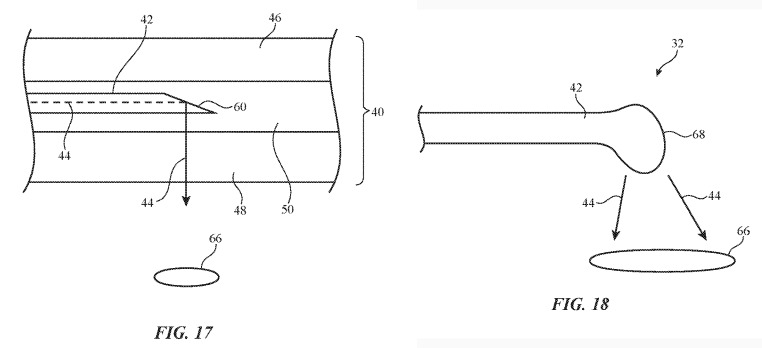Passengers in an Apple-designed car of the future may find the vehicle to have a unique interior lighting system, consisting of fiber optic-based segments that could become practically invisible when not in use by blending into the car's various surfaces, and could even offer indicators to drivers within the windscreen.
Aside from headlights and indicators, the lighting system of a vehicle generally provides its users with the ability to see in dark conditions, and not much else. While relatively simple in many vehicles, with some cars going the extra mile by adding accent lighting, Apple believes it can improve upon the currently used system.
Apple notes current systems are generally visible to the user, even when not emitting light, which may not necessarily be the best design choice. While it may also be an aesthetically appealing element, current versions can also cause problems with what they are illuminating, such as by preventing other objects from being visible.
Granted by the U.S. Patent and Trademark Office to Apple on Tuesday, the patent for "Lighting systems" suggests a fundamental shift away from bulb and LED-based methods, towards the use of optical fiber systems. The patent largely consists of ways an optical fiber can be used to transmit light and data to the user, and to create intricate shapes and other elements that could illuminate an area, look good, and potentially educate the driver about items they should know about.
While it includes creating optical fiber loops, a good deal explains how light could be transferred between a self-contained loop and a fiber acting as the main lighting infrastructure without a traditional coupling mechanism, as well as simply creating the loop using the cable.
To improve on the aesthetics, Apple suggests the system of optical fibers could be embedded between layers of transparent and translucent polymers, effectively hiding the optical fibers from view when not in use, while in the case of having some opaque elements, being able to hide sections of the optical fiber or other components that Apple doesn't want users to see.
As the layers could be transparent the whole way through, it could allow for items located beyond the polymer panel to be seen by passengers or the driver when the lighting system is turned off. It also potentially means the lights could be embedded within windows, and not just in the windshield.
The embedding of the fibers in polymer layers also means there isn't any physically touchable sections, further disguising the presence of the lighting elements.
Such a system and application may not necessarily be limited to inside the vehicle. Aside from being embedded in windows, it is feasible the fibers could be used in the headlight and tail light, a "center high-mounted stop light," and even in the body work.
While the lights could illuminate sections of a car's interior, Apple also adds in the possibility of creating directional lighting with the fibers. A light guide with a cleaved end could create a spotlight highlighting a specific part of the interior, while a bulged end could create a softer effect over an area.
Apple files numerous patent applications with the USPTO on a regular basis, and while it does show areas of the company's interest, the existence of a patent filing is not a guarantee that the concepts will make their way into a future commercial product.
There are a number of car-related patents and applications in Apple's possession, including some relating to the internal design of the vehicle. A pair of patents from August 2018 reveal ideas on how to produce a multi-track sunroof system for vehicles with a tapered roof design, along with a car seat system that can change position to warn the driver of road events, as well as bracing passengers for an impact.
In April 2018, a patent application for an augmented reality display for a vehicle suggests applying AR elements into the windscreen of a car, showing a route to where the vehicle is traveling overlaying the real-world view, or even to assist with an enhanced view of the road in low visibility conditions. If layered, it could be feasible that a similar system to the latest patent could be employed to create an in-windscreen display for this sort of purpose.
Apple has also looked into how to use gestures to control autonomous vehicles, with hand movements and poses in a designated "interaction zone" within the cabin able to instruct a vehicle on how to move.
Apple is believed to have an active interest in car design and control as part of "Project Titan," which is currently exploring and testing the use of self-driving systems. A fleet of vehicles are actively being tested on California roads, but the ultimate goal remains nebulous.
While Apple has previously looked into designing its own vehicle, it is possible the project could result in the production of a self-driving platform for use by third-party car manufacturers.
"Project Titan" itself recently hit a roadblock, after Apple confirmed plans in February to lay off 190 people from the team, including 38 engineering program managers, 33 hardware engineers, 31 product design engineers, and 22 software engineers.
 Malcolm Owen
Malcolm Owen









-m.jpg)






 Charles Martin
Charles Martin
 Christine McKee
Christine McKee
 Wesley Hilliard
Wesley Hilliard

 Andrew Orr
Andrew Orr
 William Gallagher
William Gallagher
 Sponsored Content
Sponsored Content








17 Comments
You can almost hear the teams of people at Google and Samsung scrambling ...
Apple is amassing a lot of car patents to not design nor develop its own cars.
The Car of the Future, eh? Hopefully Apple takes some lessons from the Chef of the Future.

My 1973 Cadillac had fiber optic turn signal indicators.
If you want to create something new: look to the past.